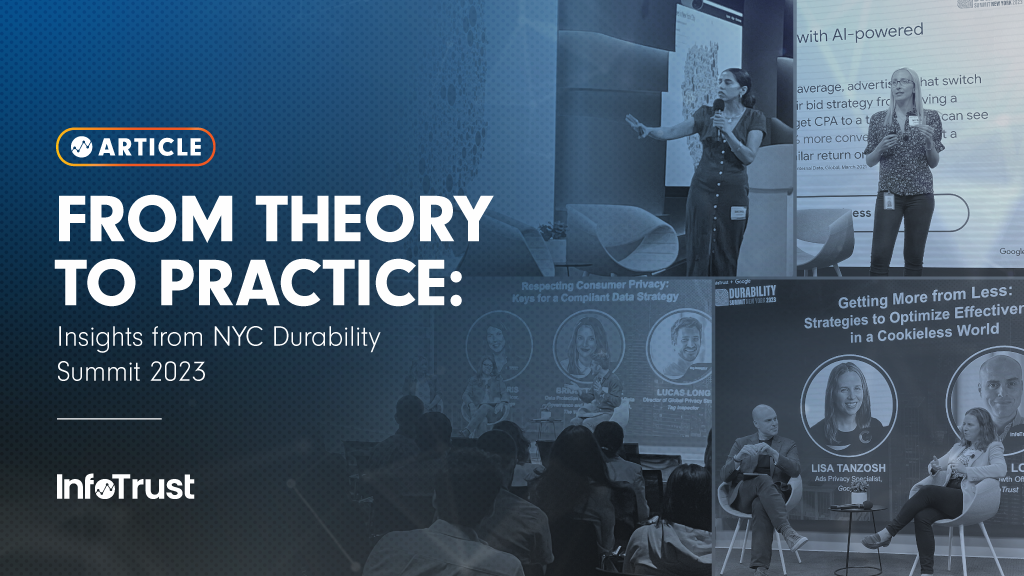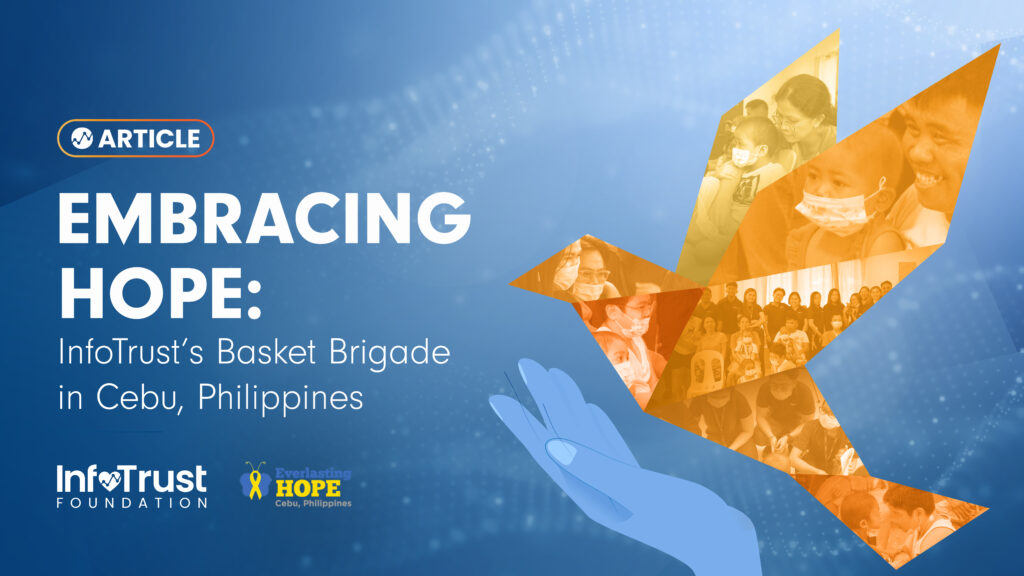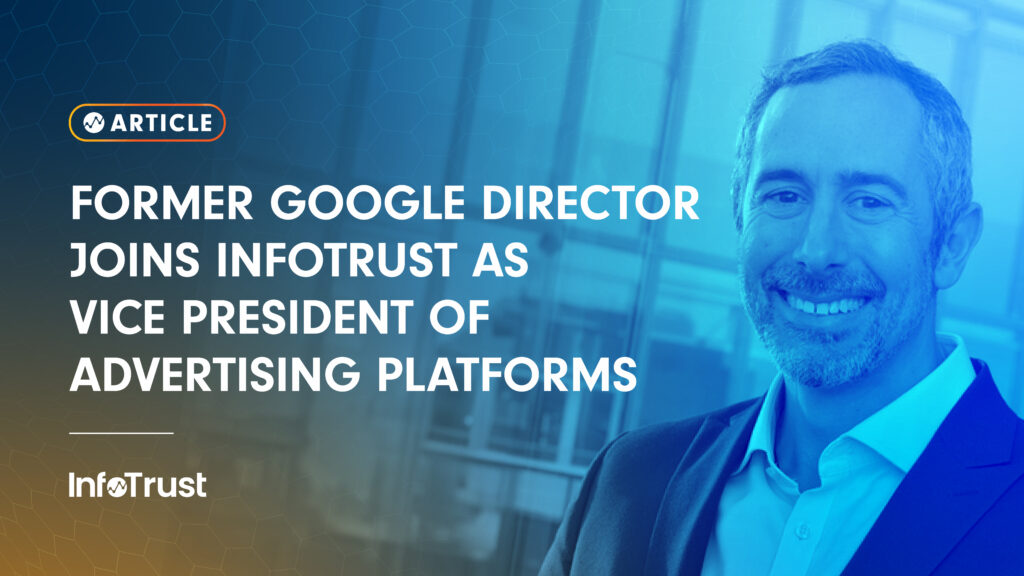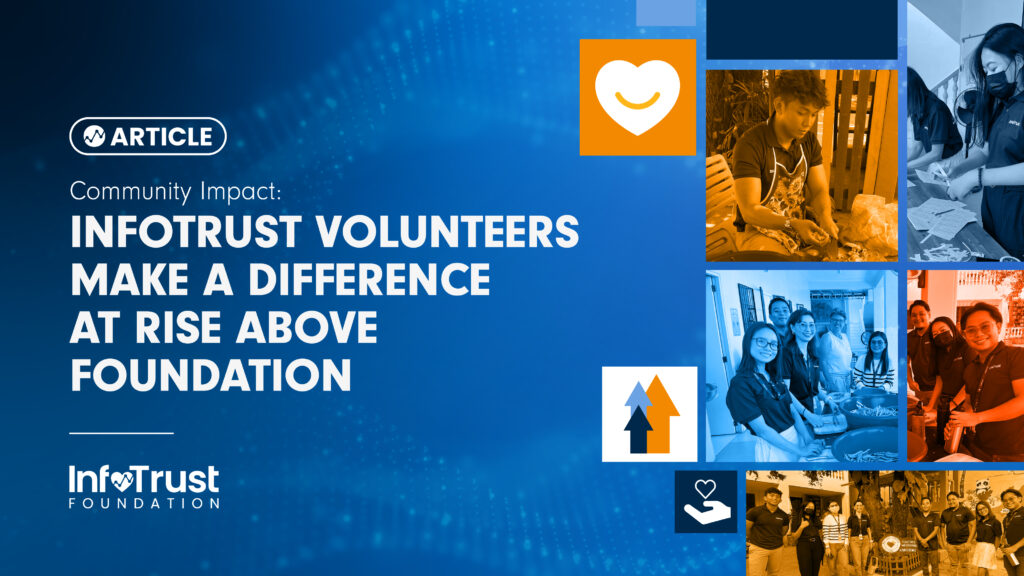The end of the reign of the third-party cookie for marketing and advertising technology is near. In May 2023, Google confirmed the timeline for their Privacy Sandbox initiative for web, signaling the last browser to support third-party cookies will be sunsetting support for the technology in the second half of 2024 as planned. With the news, as well as the ever-growing amount of privacy regulations limiting the collection and usage of consumer’s information, marketers are left with little time to transition to privacy-centric marketing strategies.
But fear not! New strategies, tactics, and technologies are flooding the space. To parse through what works, what doesn’t, and the best ways to approach the new reality we were thrilled to host eight sessions of phenomenal content at the NYC Durability Summit 2023! To catch up, check out the summaries and key takeaways to put into practice at your organization ASAP.
Data Storytelling as an Art and Science
Mona Chalabi – Data Journalist, Writer, Illustrator, Producer, and Presenter
The opening keynote from Mona Chalabi dug into the ways in which she approaches problems to find the true story through data. In the new privacy-focused environment, where less data is available and fewer signals for consumer behavior are able to be leveraged, it is critical to find insights to empower the decision-making process.
In her work, Mona seeks to go beyond the top-level headlines and delve deeper into the numbers to really highlight the who, how, and why behind many problems present in society. In many of these cases, numbers can be limited and there is limited access to the full dataset necessary to tell the story.
Sound familiar? This is the bane of existence for analysts at all organizations.
To address this problem of having less yet still needing to deliver more, she talked about how she will use the data available to extrapolate further and create the necessary dataset to communicate the story which needs to be told. Often she will find related disparate datasets to integrate and get to a place of true understanding. Doing this allows her to get deeper and understand the true picture, not just the top-level headline where most stop.
Once understanding the true picture, she uses illustration and creative techniques to re-humanize the data to really personalize the insights and make an impact on those consuming them. Doing this work to convey the story in an approachable manner removes the requirements for the viewer to find the insights themselves which often results in much being lost in translation.
Employing these techniques: integrating datasets to form a larger base to explore, digging deeper to find the true underlying phenomena, and humanizing the insights to make an impact are what will separate the good from the great for data-driven privacy-centric marketing.
Tools of the Trade: How Technology is Evolving to Meet Modern Needs of Advertisers
Steve Yap – Director, Media Technology Platforms at Google
Michael Loban – Chief Growth Officer at InfoTrust
Having been in the advertising technology industry since the late ’90s, Steve opened the discussion expressing what he wished he had known at the beginning of it all—that data would truly be the foundation of all advertising and the lifeblood of all organizations. He really wished that point would have been emphasized and the importance of first-party data would have been the central pillar for everything at the start.
After all, it is first-party data which all customer and loyalty information comes from. This is the heart of developing relationships with consumers. Too often over the past 25 years, people and platforms have lost sight of this—instead building the adtech industry around third-party cookies and passive (often intrusive) data collection. To succeed, moving forward organizations need to be much more intentional about the data being collected and how it is used.
As the focus shifts to intentional first-party data usage, organizations will have a much better understanding of exactly what is available and, more importantly, why. From this foundation, stakeholders can begin asking the critical questions about the numbers and the outputs, using data to create a meaningful conversation.
As the conversation shifted to the technology perspective, it was made apparent that we are in an exciting new era. Advances in things like AI open new possibilities for how we can interact with the data available and generate additional insights. However, even as the roles of analysts and advertisers evolve, the human element is still absolutely critical. Human intervention will be important to add context to insights, define the starting point from which to benchmark and frame the insights available, as well as to ultimately interpret what model outputs really mean for a business.
Ultimately there is a lot of noise in the industry. Advertising technology has always been on the cusp of a “new frontier”, be it the web, digital advertising more broadly, mobile, AI, or privacy disruptions. What makes the advertising industry amazing is its constant ability to change and re-invent itself, with the moment we’re in being no different. At the end of the day, just as in the past, we’re all going to be OK. Lean on both internal and external partnerships to evolve strategies, define the problems that need to be solved, and give yourself space to think about where you’ll need to be in 12 months’ time. Relying on intentional first-party data, having the right people to contextualize insights and embracing new technologies available will lead to competitive advantage.

Respecting Consumer Privacy: Keys for a Compliant Data Strategy
Jo Davaris – Chief Privacy Officer, Booking Holdings
Brigette Guyer – Data Protection Officer & Director Data Governance and Privacy Management, The Wendy’s Company
Lucas Long – Director of Privacy Strategy, Tag Inspector
The third session of the day was a panel discussion to bring the perspective of the privacy and compliance organization to the table. Jo and Brigette emphasized the importance of involving privacy and compliance teams early and often in any activity which will involve the use of customer data. It is not enough (nor is it advisable) to put together the strategy for a marketing and advertising initiative and simply bring it to the compliance team for final review and approval. Involving these stakeholders early in the design process will allow for proper guardrails to be set and for everyone to work together in order to accomplish business goals while respecting the privacy expectations of consumers.
More broadly, it is critical for organizations to develop and clearly define their privacy principles and risk appetite. Making this clear at the outset and embedding these principles within the culture of the organization gives teams a strong foundation from which to work from when developing any kind of strategy and related tactics for execution.
One of the biggest challenges organizations face is the complexity of privacy regulations and requirements, especially in the United States in the absence of centralized federal regulations and instead laws coming at the state level. Defining clear principles for topics such as transparency, user choice, and what can be done with consumer information cuts through the noise and gets everyone on the same page.
Focus on the concept of respect. While privacy laws define explicit requirements meant to ensure consumer privacy rights are respected, ultimately it is about respecting the consumer’s expectations. As consumers have become more aware about what information is being collected and how it is being used, these expectations have evolved. Yes, it is the role of the privacy and compliance teams to ensure privacy requirements are being met, but it is the role of the organization to meet and exceed consumer expectations. Marketers, advertisers, and privacy teams are all working to accomplish this goal and exceed business expectations as a result.
Taking Control of Data with Server-Side Tag Management
Tyler Blatt – Manager of Emerging Solution Strategy, InfoTrust
To follow the focus on the principle of respecting consumer’s privacy expectations, our next session focused on the principle of first-party ownership of first-party data. Tyler presented about one of the central architectural ways of making this happen with server-side tag management.
The traditional technology landscape on the web was built for signal rich targeting. Technologies were introduced to enable things like the ability to identify users across devices and platforms through third-party cookies and mobile device identifiers and sending every signal to every platform through client-side javascript tagging. These were the two foundational pieces of tech that advertising and marketing platforms were built upon, leading us to a place of ubiquitous tracking and a massive volume of third-parties receiving and processing consumer data. As consumers have become increasingly aware of what is going on, they are pushing back.
As discussed throughout all of the sessions, consumer data is critical to deliver on use cases such as generating insights for business decision, personalization, consumer experience optimization, and personalized advertising. This has not changed from where we’ve been over the past 15-20 years. The difference is that consumers only want entities that they are aware of and have a trusting relationship with to have access to that data. This is the crux of the sea change in the industry.
Thus comes the focus on first-party data (data which is shared only with the entity being directly interacted with by the consumer) and the emphasis for organizations to control, own, and protect the data they are being entrusted with. This is the data available for an organization to begin questioning and deriving the insights necessary to exceed consumer expectations.
Server-side tag management is a technical architecture which allows for consumer behavioral data from a website, application, or connected device to be sent directly to the first-party entity with which the consumer is interacting. From the business perspective, this allows for complete ownership, control, and agility with data. Data flows to an owned environment where it can be modified, enriched, and routed to any third-party platforms the business elects to use. Through this architecture, a business can ensure proper compliance and governance controls are employed, control exactly what data flows to what partner platform, and also enforce data structure and taxonomy standards to aid in downstream processing and analysis.
Server-side tag management is being adopted rapidly across the industry and represents the future of data collection and management for privacy-centric marketing organizations.
Strategy Spotlight: Aggregate Data Modeling for Measurement and Value-Based Bidding
Wynne LaBounta – Marketing Science Lead, Google
Once data is collected, it is then necessary to begin using it to advance marketing efforts. Many of the traditional tactics for activation relied upon user-level data. As data shifts from being granular and specific in nature to being more aggregate, tactics must also shift to begin leveraging these aggregated datasets for activation. Wynne presented a strategy for doing just this to enhance advertising optimization through value-based bidding.
For many organizations, visibility into critical parts of the customer journey is lost. Perhaps a consumer is introduced to the brand via an online advertising campaign bringing them to the website. But from there they do further research across other websites and accomplish the further consideration stage offline in a store. Without visibility into the full customer journey, the media team doesn’t have a proper view into what is working and how to optimize. Strategies such as media mixed modeling and experiments can be leveraged, but these leave much to be desired for more granular campaign attribution and real-time optimization through media tactics such as value-based bidding.
To fill this gap, aggregate data modeling for value-based bidding can be employed. With this approach, an organization is able to create a real-time estimate of sales attributable to ads at a granular level and generate a value-based bidding formula to enable attribution and bid optimization, all while limiting dependency on user-level data and third-party cookies.
Getting started with aggregate data modeling relies on five steps:
- Gathering data – Aggregate data required can be gathered and joined from the CRM and GMP.
- Creating and fitting the model – With the data available, fit an econometric model to predict sales as a function of online behaviors. Once fit, further optimize model performance to build confidence in model predictions. As a foundation, Google Marketing Science’s Regression Based Attribution code can be accessed here and customized for this use case.
- Identifying high value actions from the model – With model outputs, the business can identify high value actions and relative weight to leverage for value-based bidding within GMP platforms.
- Translating high value actions to activation – The model actions and weights provided in step 3 can be directly translated to value-based bidding weights applied in GMP.
- Measuring success – Success can be measured and ROAS changes estimated via A/B tests, pre/post testing, and geo experiments. Budgets can be further optimized based upon these ROAS estimates at a granular level (i.e. line item/ad group).
The technologies and modeling capabilities are available today to begin experimenting with privacy-centric strategies such as aggregate data modeling for value-based bidding.
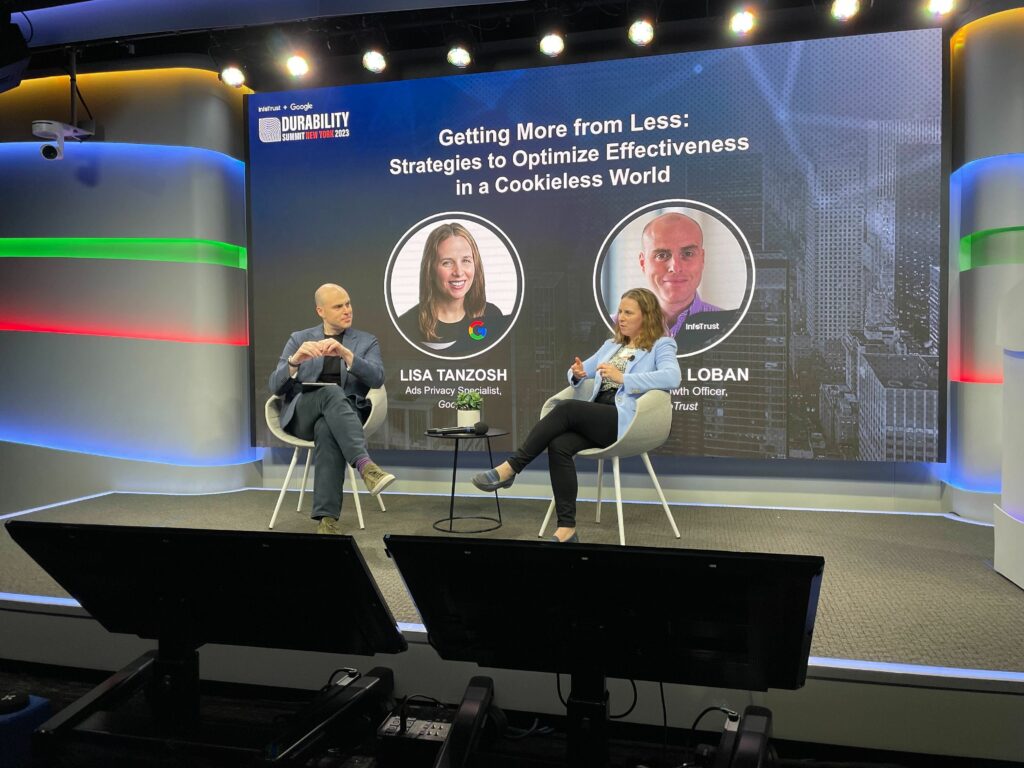
Getting More from Less: Strategies to Optimize Effectiveness in a Cookieless World
Lisa Tanzosh – Ads Privacy Specialist, Google
Michael Loban – Chief Growth Officer, InfoTrust
Lisa is responsible for helping partners understand privacy regulations and technology changes to simplify each area and apply Google’s privacy strategy. Formally, this strategy involves enhancing the focus on first-party data, leaning on capabilities from machine learning and automation, and beginning to leverage new privacy preserving technologies to accomplish traditional advertising use cases.
In the area of regulation, it is important for organizations to stay on top of the increasingly complex environment by breaking things down into core principles and themes. Some trends to be aware of in regulations are ensuring the consumer is in control of their data and businesses are transparent with their data practices, offering the consumer the ability to opt-out of processing for use cases they are uncomfortable with, making sure data from children and sensitive data is always protected, and following principles of data minimization.
By the end of 2024 it is estimated that 75 percent of the world’s population will be afforded legal privacy rights. The role of the marketer and advertiser is getting more complex. By focusing on core principles and developing a culture of respect, organizations can ensure they are moving in the right direction.
Even in the face of increasing complexity and ambiguity, privacy is not at odds with performance (but it can be inconvenient for ROI). This is the uncomfortable truth; ultimately no one knows where things will shake out. Organizations are all at different levels of maturity on the privacy-centricity spectrum with different states of first-party data, culture, how much they have been testing, etc. It is important to embrace the new reality and begin leaning into the new technologies and strategies becoming available to stay ahead of the curve. We’re all in this together.
At the end of the day, effective advertisers will be those that invest in first-party data collection architecture, lean into ML and automation tooling that exists today, take a look and experiment with new technologies available (such as the Privacy Sandbox APIs), and be able to respond and adapt to new regulations and requirements with a strong privacy strategy through a cross-functional team approach. Set yourself up in a way which ensures flexibility and a culture of testing and you will be successful moving forward.
Privacy-Focused Measurement with Google Analytics 4
Jimmy Love – Industry Team Lead, InfoTrust
One such technology available today, and relied upon by many organizations, is Google Analytics 4 (GA4). With the sunset of Universal Analytics beginning in mid-2023, thousands of businesses are completing their migration to Google’s new, and more privacy-focused, solution for behavioral data collection and activation. The core of the new platform is a shift to an event-based data model which enables a lot more flexibility in data analysis and self-service reporting, allowing analysts to do more with less.
Applying one of the central themes of the day, intentionality, the foundation of the GA4 data collection strategy should be the principle of data minimization. Collect only that which is directly relevant and necessary to accomplish defined business objectives. This principle begins with defining the business objectives for the data collected and analyzed via GA4 and extends to the design of the data architecture.
Once the use cases for GA4 are defined and the data architecture is in place, the platform offers additional features and functionality to support privacy-centric analysis.
- Granular controls for the collection of location and device data allow an organization to limit automatic data collection to that which is absolutely necessary.
- Consent Mode unlocks conversion and behavioral modeling to fill the measurement gap from unobservable actions due to consumers not consenting to cookie usage and identifier collection on a site.
- IP Anonymization by default limits exposure to a common source of compliance risk.
- New Data Redaction settings automatically identify and redact common sources of PII such as email that sneak into URLs and query parameters.
- Data Retention settings provide the ability to automatically delete data once the defined business case has been accomplished.
- Data Deletion settings allow for the deletion of user data upon a deletion request.
- Data Thresholding ensures user-level data is protected and decreases the risk of identification of a single user.
- New ML and AI features help analysts get to better insights faster and automatically customize dashboards in the platform to surface critical insights with little to no customization necessary.
Taken together, GA4 represents the future of analytics in the Google ecosystem. If you haven’t already, complete the migration to GA4 as your central source of truth for web and app measurement and ensure the privacy features available have been deployed to reduce compliance risk and optimize business utility.
Lessons from the Enterprise: Privacy-Centric Measurement and Activation
Mariam Giorgadze – Product Manager, Martech & CRM, Tory Burch
Shimi Neuwirth – Director of BI & Analytics, Adorama
Courtney Fenstermaker – Industry Team Lead, InfoTrust
In the final panel discussion of the day, leaders from enterprise teams responsible for putting privacy-centric strategies in place within their business units brought the perspective from the client-side.
Throughout the day, a lot was made about “transformation” and the evolution of strategies and tactics to accomplish marketing and advertising use cases in the new privacy-centric environment. It’s important to keep in mind that the challenges being experienced are not unique to any organization—we’re all experiencing the same shifts. With this in mind, there is an opportunity to instead internalize transformation as an awareness moment. As consumers have become more aware as to what is going on online, it’s an opportunity to reinvent how we approach the traditional outcomes marketing and advertising teams are responsible for.
To achieve these outcomes, our panelists had been focusing on a few key areas:
Educating teams
Education for internal stakeholders is not just about what new regulations and technology changes are but instead about what respect means for the consumer and what is possible technically to activate data. Educating around all of these intricacies takes time but are important to make sure strategy teams include these considerations from the start.
Building proprietary platforms
The need for control and ownership has resulted in the need to be less reliant upon third-party solutions and instead focusing on building internal platforms and capabilities to analyze and activate data. There are organizational requirements for encryption, movement of data, activation of data, and outcomes from data. To make sure all of these requirements are met there has been an increased need to build rather than buy.
Customer Data Platforms
The consolidation of customer data in a single platform for analysis, enrichment, and activation is seen as critical for future success. The consumer data within the CDP can be leveraged for activating audiences across platforms, personalization, as well as to develop deeper insights about defined customer segments to optimize consumer experience across digital and offline touchpoints.
Collecting and Using First-Party Data
New programs, such as meaningful loyalty programs, have been central to the strategy for collecting more information from consumers to power first-party data activation. It starts with formalizing the approach to the collection of identity data to allow the consumer the ability to tell the business who they are and what they want, all while making sure the consumer has the control to only share what they are comfortable with.
Even while these strategies are beginning to show returns, challenges still abound. Use cases such as attribution are extremely challenging with the lack of deterministic pseudonymous and cross-domain identifiers. There are fewer ways to understand the true full user path and make spend decisions with the data available. As a result, shifting to testing methodologies such as incrementality testing, A/B testing, holdout tests, and geo testing has begun to be operationalized. It is clear that the traditional multi-touch attribution is not where the future is, accepting that many insights are more directional in nature and making sure the context necessary to make sense of this has become the primary focus.
Looking forward, some key takeaways from the panel were that no one has everything figured out, which is OK! Most important is to test and learn within your organization to figure it out together. It is also important to make sure the privacy team is involved early in these processes for defining future strategies. At the same time, focus on education to stay on top of both challenges ahead and the emerging technologies available to address them. Work with partners both internally and externally to make sure all relevant information is surfaced and distributed to key stakeholders.
Overall, the NYC Durability Summit 2023 was a resounding success. For those who were unable to attend, hopefully the summary and key insights can help move forward your thinking for privacy-centric transformation. For those who were able to attend, thank you! And we hope to see many more of you at the next Durability Summit in San Francisco coming on October 18, 2023.
